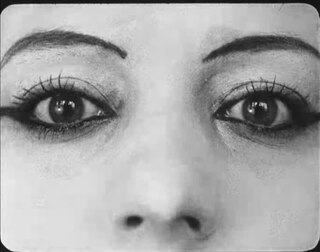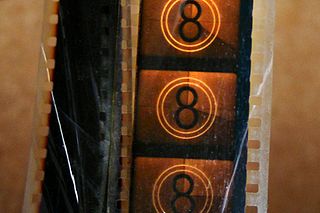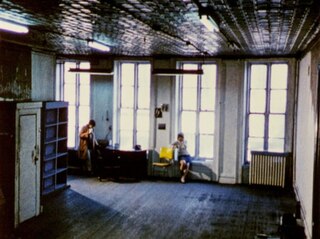Frame rate, most commonly expressed in frames per second or FPS, is typically the frequency (rate) at which consecutive images (frames) are captured or displayed. This definition applies to film and video cameras, computer animation, and motion capture systems. In these contexts, frame rate may be used interchangeably with frame frequency and refresh rate, which are expressed in hertz. Additionally, in the context of computer graphics performance, FPS is the rate at which a system, particularly a GPU, is able to generate frames, and refresh rate is the frequency at which a display shows completed frames. In electronic camera specifications frame rate refers to the maximum possible rate frames could be captured, but in practice, other settings may reduce the actual frequency to a lower number than the frame rate.
An underground film is a film that is out of the mainstream either in its style, genre or financing.

A movie projector is an opto-mechanical device for displaying motion picture film by projecting it onto a screen. Most of the optical and mechanical elements, except for the illumination and sound devices, are present in movie cameras. Modern movie projectors are specially built video projectors.

Experimental film or avant-garde cinema is a mode of filmmaking that rigorously re-evaluates cinematic conventions and explores non-narrative forms or alternatives to traditional narratives or methods of working. Many experimental films, particularly early ones, relate to arts in other disciplines: painting, dance, literature and poetry, or arise from research and development of new technical resources.

A film leader is a length of film attached to the head or tail of a film to assist in threading a projector or telecine. A leader attached to the beginning of a reel is sometimes known as a head leader, or simply head, and a leader attached to the end of a reel known as a tail leader or foot leader, or simply tail or foot.
Paracinema is an academic term to refer to a wide variety of film genres out of the mainstream, bearing the same relationship to 'legitimate' film as paraliterature like comic books and pulp fiction bears to literature.

Anthology Film Archives is an international center for the preservation, study, and exhibition of film and video, with a particular focus on independent, experimental, and avant-garde cinema. The film archive and theater is located at 32 Second Avenue on the southeast corner of East 2nd Street, in a New York City historic district in the East Village neighborhood of Manhattan.
Structural film was an avant-garde experimental film movement prominent in the United States in the 1960s. A related movement developed in the United Kingdom in the 1970s.
Paul Jeffrey Sharits was a visual artist, best known for his work in experimental, or avant-garde filmmaking, particularly what became known as the structural film movement, along with other artists such as Tony Conrad, Hollis Frampton, and Michael Snow.

Wavelength is a 1967 experimental film by Canadian artist Michael Snow. Considered a landmark of avant-garde cinema, it was filmed over one week in December 1966 and edited in 1967, and is an example of what film theorist P. Adams Sitney describes as "structural film", calling Snow "the dean of structural filmmakers."
P. Adams Sitney, is a historian of American avant-garde cinema. He is known as the author of Visionary Film, one of the first books on the history of experimental film in the United States.
The Flicker is a 1966 American experimental film by Tony Conrad. The film consists of only 5 different frames: a warning frame, two title frames, a black frame, and a white frame. It changes the rate at which it switches between black and white frames to produce stroboscopic effects.

Peter Kubelka is an Austrian filmmaker, architect, musician, curator and lecturer. His films, few in number, are known to be carefully edited and extremely brief. He is known for his 1966 Unsere Afrikareise, and for other very short and intricately-edited films.

Zorns Lemma is a 1970 American structural experimental film by Hollis Frampton. Originally starting as a series of photographs, the non-narrative film is structured around a 24-letter classical Latin alphabet. It remains, along with Michael Snow's Wavelength and Tony Conrad's The Flicker, one of the best known examples of structural filmmaking.
Hapax Legomena is a seven-part film cycle by American experimental filmmaker Hollis Frampton. The complete cycle premiered in November 1972.
The Austrian Film Museum is a film archive and museum located in Vienna, Austria. It was founded by Peter Konlechner and Peter Kubelka in 1964 as a non-profit organization.
Schwechater is a 1958 experimental short film by Austrian filmmaker Peter Kubelka. It is the second entry in his trilogy of metrical films, between Adebar and Arnulf Rainer.
Our Trip to Africa is a 1966 Austrian avant-garde short film by Peter Kubelka, originally commissioned as a travel diary documenting a wild game hunt. Kubelka used intricate editing strategies to produce a work about anti-colonialism.
All My Life is a 1966 American experimental short film directed by Bruce Baillie. It shows a continuous shot of a fence, soundtracked by Ella Fitzgerald's 1936 debut single "All My Life". Film critic P. Adams Sitney identified it as an early example of what he termed structural film.
Adebar is a 1957 Austrian avant-garde short film directed by Peter Kubelka. It is the first entry in Kubelka's trilogy of metrical films, followed by Schwechater and Arnulf Rainer. Adebar is the first film to be edited entirely according to a mathematical rhythmic strategy.








